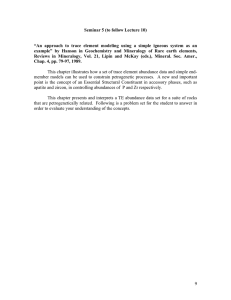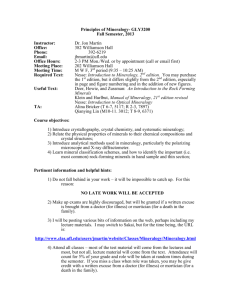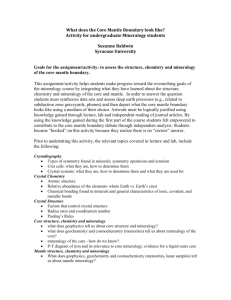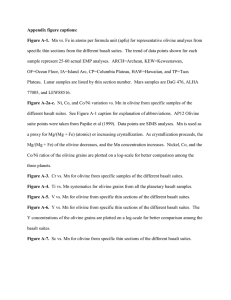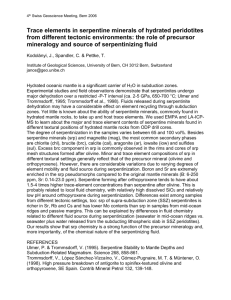Mantle Rocks.
advertisement
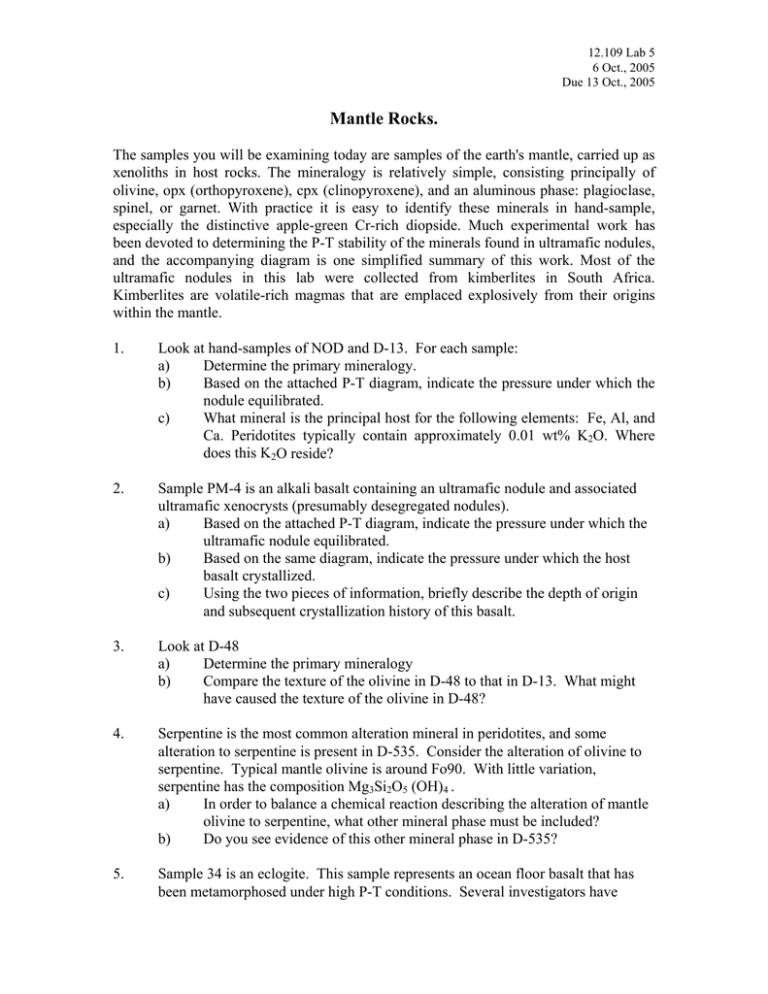
12.109 Lab 5 6 Oct., 2005 Due 13 Oct., 2005 Mantle Rocks. The samples you will be examining today are samples of the earth's mantle, carried up as xenoliths in host rocks. The mineralogy is relatively simple, consisting principally of olivine, opx (orthopyroxene), cpx (clinopyroxene), and an aluminous phase: plagioclase, spinel, or garnet. With practice it is easy to identify these minerals in hand-sample, especially the distinctive apple-green Cr-rich diopside. Much experimental work has been devoted to determining the P-T stability of the minerals found in ultramafic nodules, and the accompanying diagram is one simplified summary of this work. Most of the ultramafic nodules in this lab were collected from kimberlites in South Africa. Kimberlites are volatile-rich magmas that are emplaced explosively from their origins within the mantle. 1. Look at hand-samples of NOD and D-13. For each sample: a) Determine the primary mineralogy. b) Based on the attached P-T diagram, indicate the pressure under which the nodule equilibrated. c) What mineral is the principal host for the following elements: Fe, Al, and Ca. Peridotites typically contain approximately 0.01 wt% K2O. Where does this K2O reside? 2. Sample PM-4 is an alkali basalt containing an ultramafic nodule and associated ultramafic xenocrysts (presumably desegregated nodules). a) Based on the attached P-T diagram, indicate the pressure under which the ultramafic nodule equilibrated. b) Based on the same diagram, indicate the pressure under which the host basalt crystallized. c) Using the two pieces of information, briefly describe the depth of origin and subsequent crystallization history of this basalt. 3. Look at D-48 a) Determine the primary mineralogy b) Compare the texture of the olivine in D-48 to that in D-13. What might have caused the texture of the olivine in D-48? 4. Serpentine is the most common alteration mineral in peridotites, and some alteration to serpentine is present in D-535. Consider the alteration of olivine to serpentine. Typical mantle olivine is around Fo90. With little variation, serpentine has the composition Mg3Si2O5 (OH)4 . a) In order to balance a chemical reaction describing the alteration of mantle olivine to serpentine, what other mineral phase must be included? b) Do you see evidence of this other mineral phase in D-535? 5. Sample 34 is an eclogite. This sample represents an ocean floor basalt that has been metamorphosed under high P-T conditions. Several investigators have 12.109 Lab 5 6 Oct., 2005 Due 13 Oct., 2005 suggested that melting of eclogites could explain the formation of basalts and basaltic andesites in island arcs such as Japan. a) Identify the primary mineralogy. b) What extent of melting of an eclogite would be required to form basalt? c) Does this extent of melting seem reasonable? Explain your reasoning. 6. Look at the hand sample and thin section of 51. a) Determine the primary mineralogy b) In what P-T regime did this nodule equilibrate? 7. Kimberlites (hand samples and thin sections): 19, 33, 73, and 118. a) Identify 2 of the primary minerals in any 2 sections b) Identify 2 prominent alteration minerals in the same 2 sections c) Pick one thin section, sketch the field of view (label everything in your sketch) d) What does the primary mineralogy tell you about the composition of the magma? How is this different from a basaltic magma? Does this tell you anything (or raise any questions) about the source region for this magma? 8. Thin section LQ-2 a) Determine the primary mineralogy b) Name the rock
